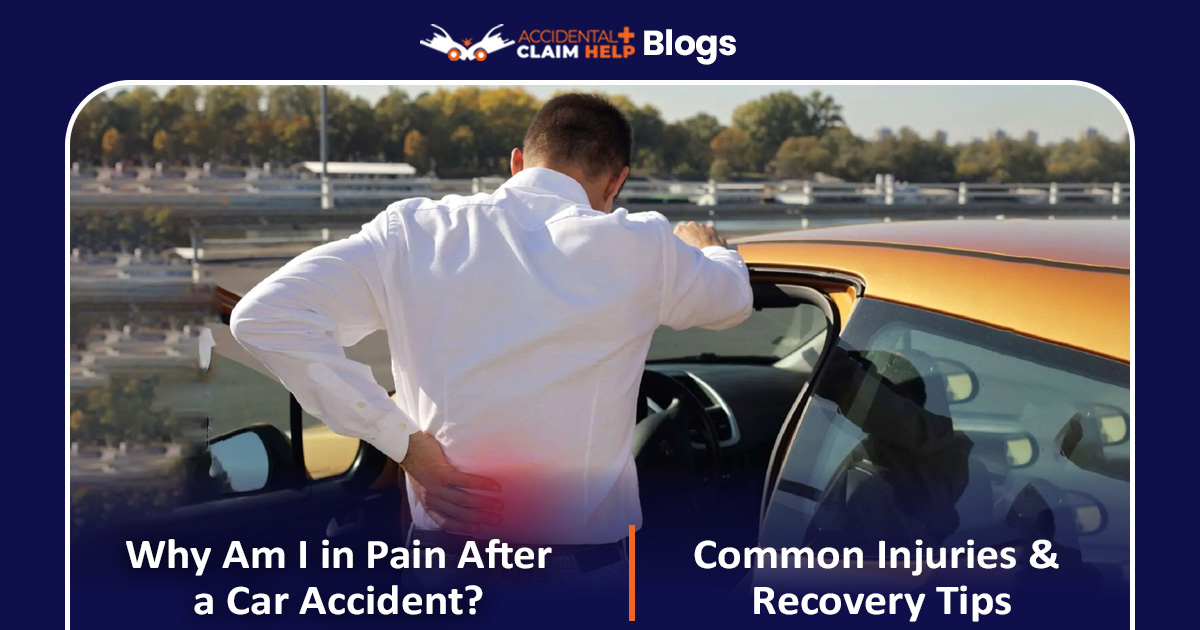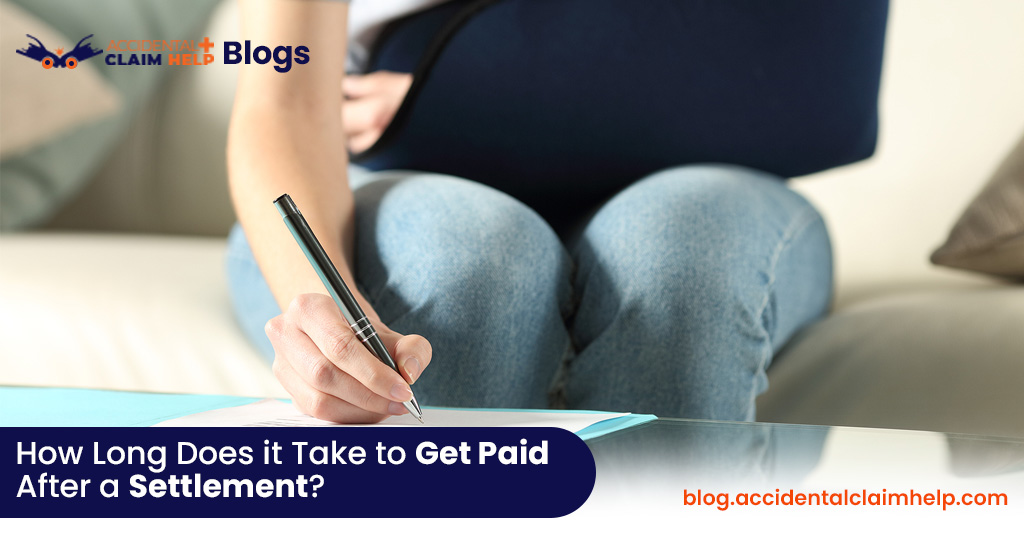Why Am I in Pain After a Car Accident? Common Injuries & Recovery Tips
Car accidents can have lasting effects, physically and emotionally. Even if the crash seemed minor, pain can show up hours or even days later. So why are you in pain after a car accident? The answer lies in the type of injuries, delayed pain responses, and how the body reacts to trauma. Knowing these injuries and how to recover will help you manage your symptoms and get the right treatment.
Overview of Post-Accident Pain
Pain after a car accident can be mild to severe and long-lasting. Some injuries are obvious, others may not show up for hours or even days due to the adrenaline response. Knowing why pain occurs, how long it will last, and what to do for recovery will help you manage your symptoms.

Common Reasons for Pain After a Car Accident
Many people feel fine after a crash and then develop pain hours or days later. This delayed onset is because the body goes into shock and releases adrenaline, which can suppress pain in the moment. Once the effects wear off, the discomfort becomes more noticeable, and injuries that were not immediately apparent become clear.
- Delayed Pain from Soft Tissue Injuries
Soft tissue injuries like whiplash and muscle strains are the most common cause of post-accident pain. Whiplash is when the head is jerked forward and backward, straining the neck and upper back muscles. While the pain may not be immediate, stiffness and soreness can develop hours or days later. Muscle strains and sprains in other parts of the body can also cause delayed pain as inflammation sets in. Bruising can take time to appear as blood collects under the skin and tenderness develops in affected areas.
- Hidden Fractures and Bone Injuries
While severe fractures are usually obvious right away, small hairline fractures or stress fractures can go unnoticed at first. Rib fractures may not be painful until you take a deep breath or move in a certain way. Small fractures in the hands, feet or spine may not become apparent until swelling and tenderness develops. Without proper diagnosis these injuries can get worse over time, so X-rays or medical evaluations are essential to detect hidden fractures.
- Nerve Damage and Tingling
Injuries to the nerves can cause chronic pain, numbness, or tingling. A herniated disc in the spine can put pressure on nearby nerves and cause back pain that radiates into the legs or arms. Pinched nerves in the neck can cause headaches, dizziness, or tingling in the shoulders and hands. If left untreated, nerve damage can lead to long-term problems, so get symptoms addressed as soon as they appear.
- Headaches and Concussion Symptoms
Headaches after a car accident can be a sign of a concussion, whiplash, or stress-related tension. Concussions, even mild ones, can cause dizziness, nausea, memory problems, and difficulty concentrating. Whiplash headaches come from strained neck muscles, post-traumatic migraines from stress, and brain impact. Since head injuries can have long-term effects, get medical attention if headaches persist or worsen.

- Back and Spinal Cord Injuries
Back pain after a collision is common, often from muscle strain, herniated discs or spinal misalignment. Lower back strains are common in rear end collisions and cause stiffness and discomfort. More severe spinal injuries like herniated discs can cause chronic pain and limited mobility. If left untreated, these conditions can lead to long-term problems that affect daily activities. Diagnostic imaging, like MRIs or X-rays, can help identify spinal injuries and determine the best course of treatment.
Recovery Tips for Post-Accident Pain
Healing after a car accident is a combination of medical care, self-care, and patience. Even if pain seems minor at first, get symptoms addressed early to prevent them from getting worse over time.
- Get Medical Attention Right Away
See a doctor after a car accident, even if you don’t feel immediate pain. A thorough medical exam can find hidden injuries before they get worse. Doctors may recommend X-rays, MRIs, or other tests to find fractures, soft tissue injuries, or nerve damage. Follow medical advice and keep track of symptoms so any complications are addressed right away.
- Use Cold and Heat:
Cold and heat can help with pain and healing. Ice packs are most effective in the first 48 hours after an injury to reduce swelling and numbness. Once the inflammation goes down, heat can help relax muscles and improve circulation. Alternating between cold and hot can provide relief and speed up the healing process.
- Get Physical Therapy for Faster Recovery
Physical therapy is key to getting mobility back and reducing pain. Stretching and strengthening exercises can improve flexibility and prevent stiffness. Manual therapy, like massage and joint manipulation, can relieve muscle tightness and improve circulation. A physical therapist can create a customized recovery plan to address your specific injuries and get you back to normal faster.
- Manage Pain with Medications and Other Options
Pain management is often a combination of medication and other treatments. Over-the-counter anti-inflammatory meds like ibuprofen can help with swelling and discomfort. Some people find relief with chiropractic adjustments, which align the spine to relieve pressure on nerves and muscles. Acupuncture and massage therapy also help with relaxation and circulation. Consulting with a doctor ensures the chosen pain management plan is safe and effective.
- Rest and Gradual Movement
While rest is necessary for recovery, too much inactivity can lead to stiffness and slow down the healing process. You need to find a balance between rest and gentle movement. Avoid activities that worsen injuries, but do light exercises like walking or stretching to prevent stiffness. Listen to your body and don’t overdo it to prevent setbacks and aid in steady recovery.
When to See a Doctor for Persistent Pain
While minor pain may improve with self-care, some symptoms need immediate medical attention. Severe or worsening pain, numbness, tingling, or weakness should not be ignored. Difficulty breathing, chest pain, or loss of balance after a head injury are also red flags that need medical evaluation. Seeing a doctor ensures underlying injuries are treated properly and prevents long-term complications.
FAQs
How to treat pain after a car accident?
Pain can be treated with rest, ice or heat, and over-the-counter pain meds. Physical therapy and chiropractic care helps with mobility and long term healing. Getting medical attention ensures proper diagnosis and treatment for hidden injuries.
How to recover from accident injuries?
Recovery is following a doctor’s treatment plan, staying active with gentle exercises, and getting enough rest. Physical therapy and pain management techniques like massage or acupuncture can speed up healing. Proper nutrition and hydration also help the body’s natural recovery process.
What helps back pain from a car accident?
Ice or heat, gentle stretches, and good posture can help with back pain. Chiropractic adjustments and physical therapy help with spinal alignment and reduce discomfort. Pain meds or anti-inflammatory meds may be prescribed for severe cases.
How to get rid of injury pain?
Injury pain management is a combination of rest, meds, physical therapy and lifestyle changes. Alternative therapies like acupuncture, massage and chiropractic care can help. Following a recovery plan consistently ensures long term pain reduction and mobility.
Final Thoughts
Pain after a car accident is common and doesn’t always show up right away. Injuries like soft tissue damage, fractures, nerve damage, and spinal misalignment can cause discomfort that develops over time. Seeing a doctor promptly, following a structured recovery plan, and using effective pain management techniques can speed up the healing process. If pain persists or worsens, see a doctor to ensure full recovery and prevent long-term complications.







